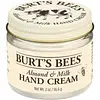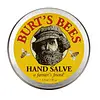What's inside
What's inside
 Key Ingredients
Key Ingredients

 Benefits
Benefits

 Concerns
Concerns

 Ingredients Side-by-side
Ingredients Side-by-side

Prunus Amygdalus Dulcis Oil
Skin ConditioningWater
Skin ConditioningBeeswax
Emulsion StabilisingPolyglyceryl-3 Oleate
EmulsifyingAloe Barbadensis Leaf Juice
Skin ConditioningKaolin
AbrasiveNonfat Dry Milk
Skin ConditioningTocopherol
AntioxidantLonicera Japonica Flower Extract
Skin ConditioningLonicera Caprifolium Flower Extract
PerfumingGlycine Soja Oil
EmollientLecithin
EmollientCitric Acid
BufferingCarrageenan
Sucrose
HumectantAlcohol
AntimicrobialStearic Acid
CleansingAscorbyl Palmitate
AntioxidantGlyceryl Oleate
EmollientGlyceryl Stearate
EmollientPotassium Sorbate
PreservativeSodium Benzoate
MaskingSodium Phytate
Parfum
MaskingPhenoxyethanol
PreservativeBenzyl Salicylate
PerfumingEugenol
PerfumingLinalool
PerfumingPrunus Amygdalus Dulcis Oil, Water, Beeswax, Polyglyceryl-3 Oleate, Aloe Barbadensis Leaf Juice, Kaolin, Nonfat Dry Milk, Tocopherol, Lonicera Japonica Flower Extract, Lonicera Caprifolium Flower Extract, Glycine Soja Oil, Lecithin, Citric Acid, Carrageenan, Sucrose, Alcohol, Stearic Acid, Ascorbyl Palmitate, Glyceryl Oleate, Glyceryl Stearate, Potassium Sorbate, Sodium Benzoate, Sodium Phytate, Parfum, Phenoxyethanol, Benzyl Salicylate, Eugenol, Linalool
 Reviews
Reviews

Ingredients Explained
These ingredients are found in both products.
Ingredients higher up in an ingredient list are typically present in a larger amount.
Glycine Soja Oil comes from the soybean. Glycine Soja is native to eastern Asia.
Soybean oil is an emollient. It is rich in antioxidants and fatty acids including palmitic, stearic, oleic, and linoleic acids.
As an emollient, the fatty acids in soybean oil helps keep your skin soft and hydrated. It does so by creating a film on top that traps moisture in.
Soybean oil is also rich in vitamin E, a potent antioxidant. Vitamin E is also anti-inflammatory and provides a soothing effect.
Studies show soy may help fade hyperpigmentation from UVB. It does so by disrupting the melanin process from UVB induced skin inflammation.
This ingredient may not be malassezia folliculitis, or fungal-acne, safe.
Soybeans are rich in proteins and are part of the legume family. Foods made with soybeans include tofu, soymilk, edamame, miso, and soy sauce.
Learn more about Glycine Soja OilLinalool is a fragrance and helps add scent to products. It's derived from common plants such as cinnamon, mint, citrus, and lavender.
Like Limonene, this ingredient oxidizes when exposed to air. Oxidized linalool can cause allergies and skin sensitivity.
This ingredient has a scent that is floral, spicy tropical, and citrus-like.
Learn more about LinaloolPrunus Amygdalus Dulcis Oil comes from the sweet almond, a tree native to Iran. This oil has no fragrance and is non-volatile.
Almonds contain healthy fats, vitamins, and minerals. It is a rich source of Vitamin E, a great antioxidant and skin conditioning ingredient. Sweet almond oil contains fatty acids such as linolenic acid and triglycerides.
The content of sweet almond oil makes it a great emollient; it can help soften and hydrate your skin. Emollients create a barrier over your skin to trap moisture in. Sweet almond oil has antioxidant properties.
Those with an almond allergy should be careful of this ingredient and speak with a professional about using it in your skincare.
This ingredient may not be fungal-acne safe.
Learn more about Prunus Amygdalus Dulcis OilTocopherol (also known as Vitamin E) is a common antioxidant used to help protect the skin from free-radicals and strengthen the skin barrier. It's also fat soluble - this means our skin is great at absorbing it.
Vitamin E also helps keep your natural skin lipids healthy. Your lipid skin barrier naturally consists of lipids, ceramides, and fatty acids. Vitamin E offers extra protection for your skin’s lipid barrier, keeping your skin healthy and nourished.
Another benefit is a bit of UV protection. Vitamin E helps reduce the damage caused by UVB rays. (It should not replace your sunscreen). Combining it with Vitamin C can decrease sunburned cells and hyperpigmentation after UV exposure.
You might have noticed Vitamin E + C often paired together. This is because it is great at stabilizing Vitamin C. Using the two together helps increase the effectiveness of both ingredients.
There are often claims that Vitamin E can reduce/prevent scarring, but these claims haven't been confirmed by scientific research.
Learn more about Tocopherol